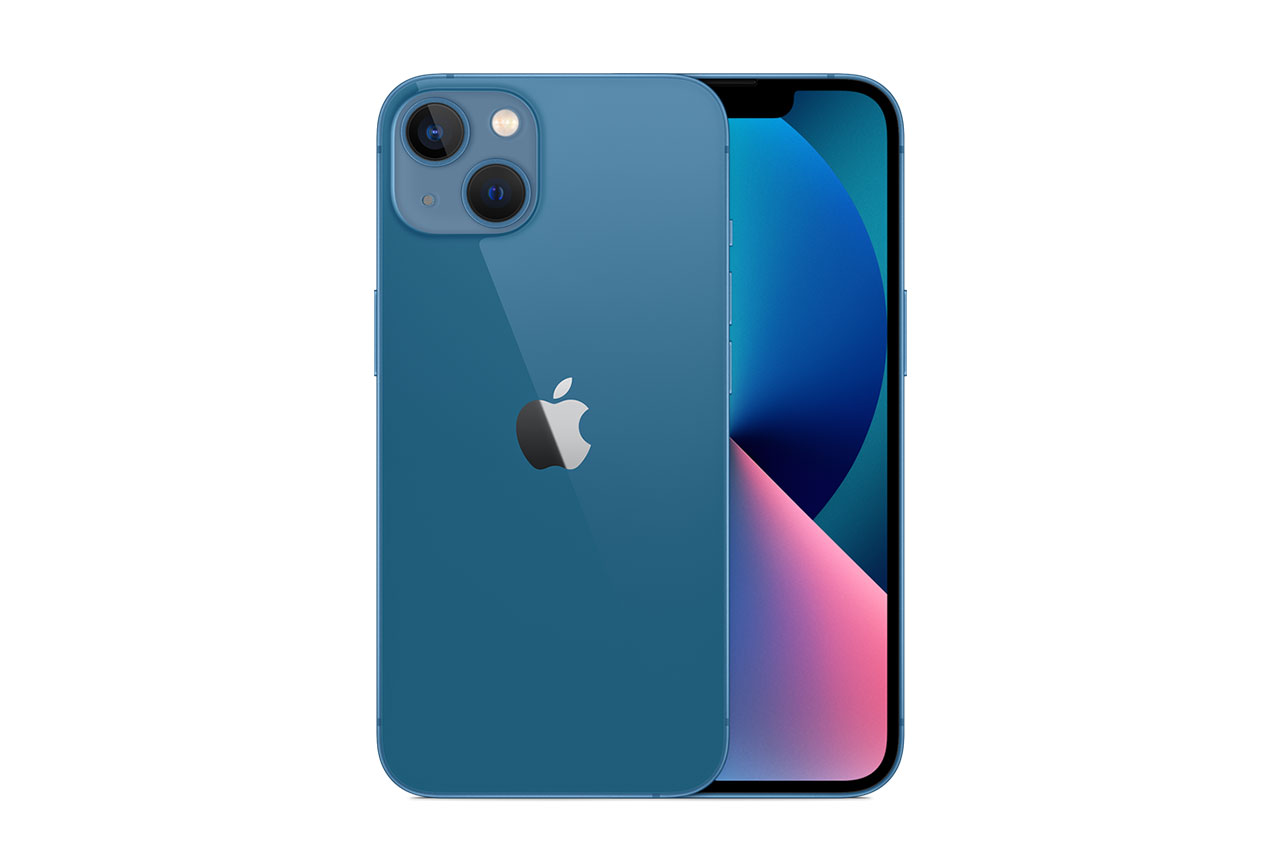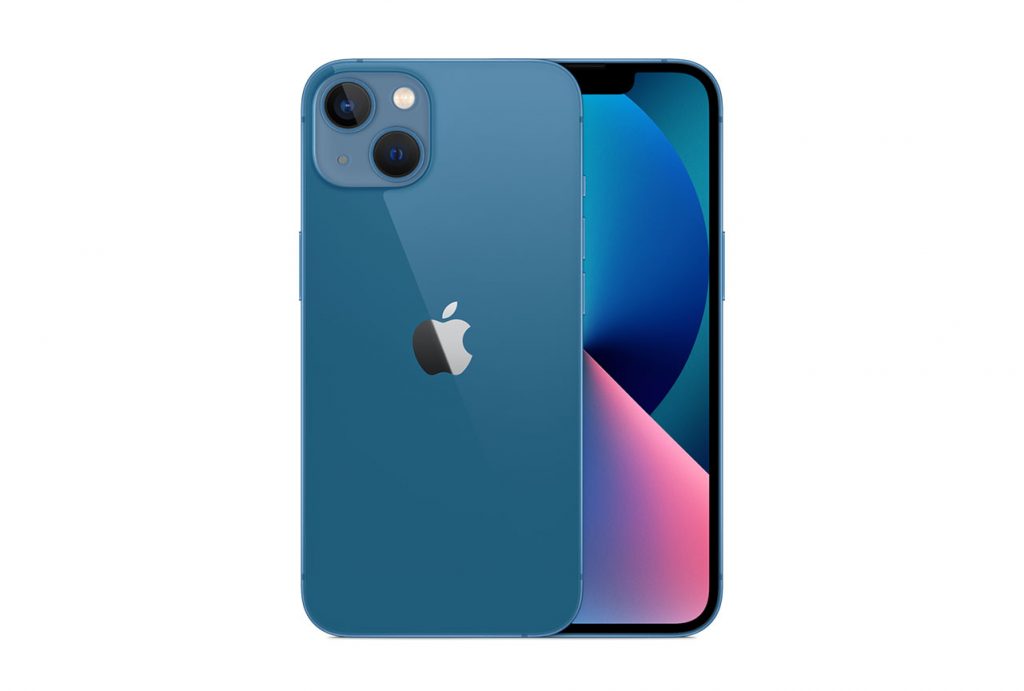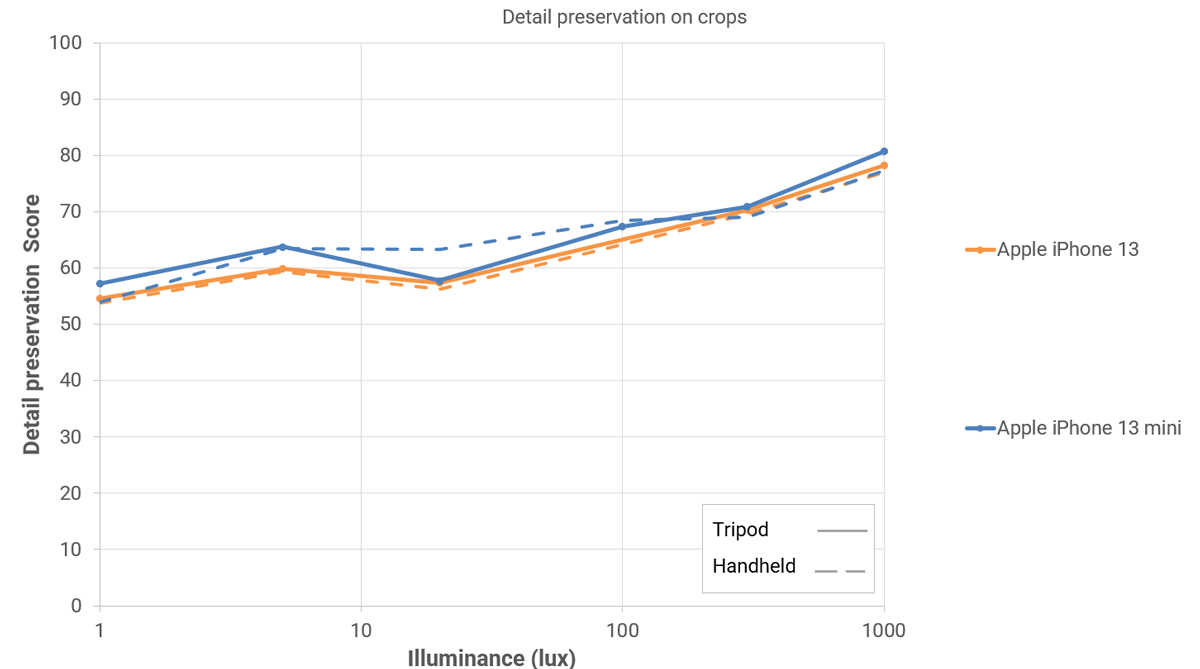The Apple iPhone 13 shares most specs, including the camera setup, with the smaller iPhone 13 mini. The main difference is the size of the Super Retina XDR display which measures 6.1 inches on the iPhone 13 and 5.4 on the mini. The device is powered by Apple’s own A15 chipset and available with up to 512GB of built-in storage.
In the camera department, the iPhone 13 cannot offer a dedicated tele module but comes with several improvements over last year’s generation. The new primary module uses the same size sensor as last year’s top-of-the-line iPhone 12 Pro Max and there is now Dual-Pixel autofocus instead of PDAF. Light is channeled through an f/1.6-aperture lens and a sensor-shift stabilization system is keeping things steady. The primary module is accompanied by an ultra-wide camera that features the same tech specs as on the iPhone 12 generation.
Read on to find out how the all-new iPhone 13 camera performed in our DXOMARK Camera tests.
Key camera specifications:
- Primary: 12 MP sensor, 1.7µm pixels, 26 mm equivalent f/1.6-aperture lens, Dual-Pixel AF, sensor-shift OIS
- Ultra-wide: 12 MP sensor 13 mm equivalent f/2.4-aperture lens, 120-degree field of view
- 4K video at 24/25/30/60 fps, 1080p at 25/30/60 fps, HDR with Dolby Vision
About DXOMARK Camera tests: For scoring and analysis in our smartphone camera reviews, DXOMARK engineers capture and evaluate over 3000 test images and more than 2.5 hours of video both in controlled lab environments and in natural indoor and outdoor scenes, using the camera’s default settings. This article is designed to highlight the most important results of our testing. For more information about the DXOMARK Camera test protocol, click here. More details on how we score smartphone cameras are available here.
Test summary
Scoring
Sub-scores and attributes included in the calculations of the global score.
 Apple iPhone 13
Apple iPhone 13

125
camera
109
Huawei Pura 70 Ultra
Best: Huawei Pura 70 Ultra (130)
116
Apple iPhone 16 Pro
Best: Apple iPhone 16 Pro (130)
109
Huawei Pura 70 Ultra
Best: Huawei Pura 70 Ultra (125)
100
Xiaomi 15 Ultra
Best: Xiaomi 15 Ultra (125)
82
Huawei Pura 70 Ultra
Best: Huawei Pura 70 Ultra (117)
70
Xiaomi Redmi 12 5G
Best: Xiaomi Redmi 12 5G (82)
65
Huawei Pura 70 Ultra
Best: Huawei Pura 70 Ultra (85)
76
Apple iPhone 16 Pro
Best: Apple iPhone 16 Pro (93)
39
Xiaomi 15 Ultra
Best: Xiaomi 15 Ultra (128)
87
Huawei Pura 70 Ultra
Best: Huawei Pura 70 Ultra (122)
111
Oppo Find X8 Pro
Best: Oppo Find X8 Pro (116)
114
Oppo Find X8 Pro
Best: Oppo Find X8 Pro (120)
115
Huawei Pura 70 Ultra
Best: Huawei Pura 70 Ultra (120)
109
Oppo Find X6 Pro
Best: Oppo Find X6 Pro (118)
111
Apple iPhone 16 Pro
Best: Apple iPhone 16 Pro (120)
75
Xiaomi 12S Ultra
Best: Xiaomi 12S Ultra (86)
112
Apple iPhone 16 Pro
Best: Apple iPhone 16 Pro (119)
Use cases & Conditions
Use case scores indicate the product performance in specific situations. They are not included in the overall score calculations.
Outdoor
Photos & videos shot in bright light conditions (≥1000 lux)
Indoor
Photos & videos shot in good lighting conditions (≥100lux)
Lowlight
Photos & videos shot in low lighting conditions (<100 lux)
Friends & Family
Portrait and group photo & videos
Please be aware that beyond this point, we have not modified the initial test results. While data and products remain fully comparable, you might encounter mentions and references to the previous scores.
Position in Global Ranking

93
rd
4. Apple iPhone 16 Pro Max
157
10. Apple iPhone 15 Pro Max
154
22. Honor Magic4 Ultimate
147
26. Apple iPhone 14 Pro Max
146
26. Motorola Edge 50 Ultra
146
26. Samsung Galaxy S25 Ultra
146
32. Samsung Galaxy S24 Ultra
144
35. Apple iPhone 13 Pro Max
141
35. Google Pixel 9 Pro Fold
141
39. Samsung Galaxy S23 Ultra
140
44. Tecno Camon 40 Pro 5G
138
46. Vivo X80 Pro (Snapdragon)
137
53. Samsung Galaxy S22 Ultra (Snapdragon)
135
53. Vivo X80 Pro (MediaTek)
135
60. Samsung Galaxy Z Fold6
133
60. Samsung Galaxy S24+ (Exynos)
133
60. Samsung Galaxy S24 FE
133
60. Samsung Galaxy S24 (Exynos)
133
70. Samsung Galaxy Z Flip6
132
71. Apple iPhone 12 Pro Max
131
71. Samsung Galaxy S22 Ultra (Exynos)
131
82. Samsung Galaxy Z Fold5
128
84. Asus Smartphone for Snapdragon Insiders
127
84. Samsung Galaxy Z Flip5
127
84. Samsung Galaxy S23 FE
127
89. Vivo X70 Pro (MediaTek)
126
93. Asus Zenfone 11 Ultra
125
93. Samsung Galaxy S22+ (Exynos)
125
98. Samsung Galaxy Z Fold4
124
101. Apple iPhone 11 Pro Max
122
106. Xiaomi Redmi Note 13 Pro Plus 5G
121
107. Samsung Galaxy Z Fold3 5G
120
107. Samsung Galaxy S22 (Exynos)
120
107. Xiaomi Redmi Note 13 Pro 5G
120
112. Xiaomi Redmi Note 14 Pro+ 5G
118
115. Apple iPhone 12 mini
117
115. Samsung Galaxy S21 Ultra 5G (Snapdragon)
117
115. Samsung Galaxy S21 FE 5G (Snapdragon)
117
115. Samsung Galaxy S21 5G (Snapdragon)
117
121. Vivo X60 Pro 5G (Snapdragon)
116
124. Motorola Edge 50 Neo
115
124. Samsung Galaxy S21+ 5G (Snapdragon)
115
124. Samsung Galaxy S21 Ultra 5G (Exynos)
115
134. Crosscall Stellar-X5
113
134. Xiaomi Redmi Note 12 Pro+ 5G
113
138. Samsung Galaxy Z Flip4
112
140. Samsung Galaxy Z Flip3 5G
111
140. Samsung Galaxy S21+ 5G (Exynos)
111
140. Samsung Galaxy S21 5G (Exynos)
111
145. Samsung Galaxy A55 5G
108
145. Vivo X60 Pro 5G (Exynos)
108
150. Samsung Galaxy A54 5G
107
151. Xiaomi Redmi Note 14 Pro 5G
106
154. Samsung Galaxy A35 5G
104
155. Motorola Edge 40 Neo
103
155. Xiaomi Redmi Note 14 5G
103
157. Xiaomi Redmi Note 12 Pro 5G
102
159. Motorola Edge 30 Pro
101
161. Apple iPhone SE (2022)
100
163. Motorola Moto g75 5G
96
169. Samsung Galaxy A34 5G
92
169. Samsung Galaxy A25 5G
92
173. Xiaomi Redmi Note 13 5G
91
175. Motorola Moto g85 5G
88
175. Samsung Galaxy A52s 5G
88
175. Samsung Galaxy A52 5G
88
179. Motorola moto g54 5G
85
179. Samsung Galaxy A33 5G
85
179. Samsung Galaxy A16 LTE
85
182. Honor Magic6 Lite (5300 mAh)
84
182. Xiaomi Redmi Note 14
84
185. Samsung Galaxy A15 5G
83
187. Samsung Galaxy A15 LTE
81
188. Samsung Galaxy A53 5G
79
190. Xiaomi Redmi Note 11 Pro 5G
78
192. Samsung Galaxy A16 5G
77
194. Motorola Moto G35 5G
75
194. Xiaomi Redmi Note 13
75
197. Honor Magic5 Lite 5G
74
199. Samsung Galaxy A23 5G
70
200. Xiaomi Redmi Note 12 5G
69
203. Motorola moto g34 5G
67
203. Samsung Galaxy A14 5G
67
205. Motorola Moto G62 5G
66
206. Xiaomi Redmi Note 11S 5G
65
208. Xiaomi Redmi Note 12
63
213. Honor Magic4 Lite 5G
61
215. Xiaomi Redmi Note 11
60
217. Crosscall Stellar-M6
59
224. Xiaomi Redmi 10 2022
51
226. Samsung Galaxy A22 5G
48
Position in Premium Ranking

17
th
8. Samsung Galaxy S24 (Exynos)
133
16. Vivo X70 Pro (MediaTek)
126
20. Samsung Galaxy S22 (Exynos)
120
21. Samsung Galaxy S21 FE 5G (Snapdragon)
117
21. Samsung Galaxy S21 5G (Snapdragon)
117
25. Vivo X60 Pro 5G (Snapdragon)
116
30. Samsung Galaxy S21 5G (Exynos)
111
32. Vivo X60 Pro 5G (Exynos)
108
Pros
- Accurate and repeatable target exposure
- Generally nice colors and white balance, pleasant skin tones in most light conditions, even in complex backlit scenes
- Fast, accurate and repeatable autofocus
- Good detail in daylight and under indoor lighting
- Accurate and stable exposure, wide dynamic range in video
- Good texture/noise trade-off in video
- Accurate white balance in video, smooth transition on scene changes
- Mostly accurate and smooth video autofocus
Cons
- Luminance noise on primary and ultra-wide cameras, especially in low light
- Limited dynamic range in challenging high contrast scenes
- Image artifacts, including flare, slight ringing and color quantization
- Limited detail when using medium to long-range zoom
- Noise in video, especially in low light
- Lens flare and ghosting in video, especially in low light
- Some loss of texture in video, especially on faces in daylight and indoor conditions
- Sharpness differences between video frames, strong residual motion in videos recorded while running
With the Apple iPhone 13 and iPhone 13 mini sharing the same rear camera specs and processor, it’s fair to assume the Apple iPhone 13 results are very close to those of the iPhone 13 MINI in all conditions. We have confirmed this by putting the Apple iPhone 13 through the complete DXOMARK Camera test protocol. Let’s have a look at a few examples.
When capturing these outdoor scenes the iPhone 13 and 13 mini produce virtually identical image results.
Apple iPhone 13, accurate target exposure, nice colors
Apple iPhone 13 mini, very similar exposure and color
The same is true for this indoor scene. Both cameras manage good exposure and nice colors. In the 100% crop you can see that some luminance noise is noticeable.
Apple iPhone 13, indoor scene, good target exposure, nice color
Apple iPhone 13, crop: good detail, some luminance noise
Apple iPhone 13 mini, pretty much identical exposure and color
Apple iPhone 13 mini, crop: pretty much identical noise
The measurements for detail in the lab are very close between the two models across all light levels and conditions.
Detail comparison: very similar level of detail as the iPhone 13 mini
The situation is the same for video as it is for the still images. Video clips captured with the Apple iPhone 13 and iPhone 13 mini look very similar.
Apple iPhone 13, nice color, good exposure and detail, but also some flare
Apple iPhone 13 mini, very similar video performance
Given the identical results, we are posting only this short article for the Apple iPhone 13. For the full set of of sample images and measurements as well as a complete analysis, please click on the link below and read the full review of the Apple iPhone 13 mini.
Go to the Apple iPhone 13 mini Camera review



 93rd
93rd 17th
17th







DXOMARK encourages its readers to share comments on the articles. To read or post comments, Disqus cookies are required. Change your Cookies Preferences and read more about our Comment Policy.